-
EnginePermanent-magnet synchronous AC
-
Power228 HP / 310 LB-FT (est.)
-
TransmissionDirect Drive
-
0-60 Time5.6 Sec.
-
Top Speed130 MPH
-
DrivetrainRWD
-
Engine PlacementRear
-
Curb Weight3,814 LBS
-
Seating2+3
-
Cargo15 Cu. Ft.
-
MPG136 City / 123 HWY (eMPG)
-
Base Price$35,000
-
As Tested Price$57,500
SAN JOSE, Calif. — When the Tesla Model 3 appeared in production form last summer, the hype was already at a fever pitch after months — years, even — of anticipation. With hundreds of thousands of reservations already on the books, it appeared this could be the car that transforms Tesla from a startup to a true competitor. Then, crickets, for most customers anyway. Production delays have left customers frustrated and analysts speculative about the company's future. With that in mind, we found an owner lucky enough to have already received his Long Range Model 3 — and kind enough to let us drive it — and we traveled to Silicon Valley to see what all the hubbub is about.
Model 3 production is off to a slow start, but the first units produced are top-of-the-line, far above the $35,000 base price. The long-range battery ($9,000) normally provides 310 miles of driving range, but the 19-inch wheels ($1,500) reduce that to 290 miles. The high-end interior includes heated power seats, premium audio, tinted glass roof, power heated and folding mirrors, LED fog lights, and integrated smartphone docking. Our tester was also equipped with Advanced Autopilot, worth $5,000, which to quote Tesla, "will match speed to traffic conditions, keep within a lane, automatically change lanes, transition from one freeway to another, exit the freeway and self-park at your destination." It also includes the promise, "Additional features will roll out over time through software updates." Total price on our tester: $57,500 including a grand in destination charges. Later this year, Tesla expects to begin producing the smaller-battery Model 3s, which start at $35,000 and offer 220 miles of range.
Our first impression of the Model 3 as it sat in a crowded parking lot was that it actually blends in pretty well. While a Model S (or especially a Model X) will grab our attention as it passes through our peripheral vision, this more affordable Tesla is far less likely to turn our head from a distance. We found this to be the case on the road, too, despite the 3's current status of rarity. Granted, this Model 3 was a more subdued paint choice in Silver Metallic (a $1,000 option, as is any color but black), and Silicon Valley is, after all, the land of Tesla, and has a dense population of flashier exotics. We just didn't get other drivers or pedestrians craning their necks for a closer look at the Model 3 like we might back home in Michigan.
Upon closer inspection, though, the Model 3's quirks make themselves apparent right away. The novel exterior handle that emerges from the bodywork, and the push-button door opener on the interior remind you this car is different every time you get in or out of it. The overarching theme is high-tech and novel, from the cameras in the B-pillar and on the front fender to the sheer minimalism of the dash in front of you, broken up by the giant central touchscreen. The lack of an instrument cluster behind the steering wheel is a bit disorienting. While we got eventually got used to looking to our right to check our speed, it is not ideal packaging.
Right away, we looked the car over for these oft-maligned remnants of poor build quality. Frankly, based on our experience with this single vehicle, they're overstated, at least from a visual standpoint. If we hadn't been hearing about it, we wouldn't have noticed that the panel gaps (many of which are along curves in the sheet metal) are marginally wider than other vehicles. We didn't see any chrome strips that didn't line up, something we've noticed on GM vehicles. The only thing that really stood out to us was a couple flat spots in the paint, but we can't be sure those didn't happen after the build. Given its early days in Model 3 production, there's probably variance between individual cars, and without discounting those real issues, the car we tested was acceptably screwed together.
The inside of the Model 3 is roomy. Six-footers can sit behind six-footers and be happy. Space in the frunk is limited to shorter luggage — it's perfect for a hefty gym bag but unsuitable for paper grocery bags. The room behind the rear seats is ample for that. One beautiful thing about the Model 3 is the way the space opens up when you fold the rear seats down. We won't spoil the visual, but check out our list of five cool features to see how an out-of-shape dad fares on an inflatable twin mattress in the back of the Model 3.
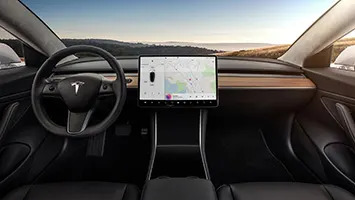
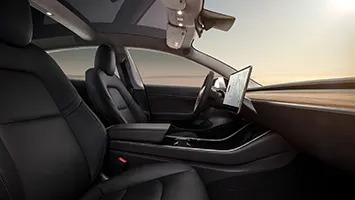
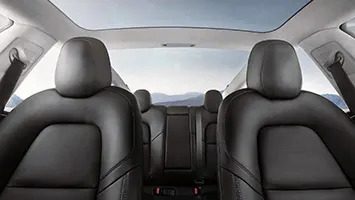

The interior materials feel appropriate for the price point: upscale where you need it, and the harder bits are at least nice to look at. The leather steering wheel is smooth, slightly soft (al dente, maybe) and grippy. The wood across the dash looks nice, but the piano black plastic on the doors and center console was already showing some minor surface wear — we were warned that it could scratch easily. The doors have leather handles and strips of ultrasuede trim. The seats are very comfortable and supportive, but we would've loved to have ventilated chairs — which Tesla has even discontinued in the Models S and X — in the California sun. The giant touchscreen looks heavy, but it is firmly attached, and didn't wiggle a bit when we messed with it. The magnetic cargo lids in the center console require an unusually gentle touch to get them to stay shut (we thought they were broken when we first tried to close them).
The interesting part of centralizing most of the controls on the central display is how little you're touching the rest of the interior. Beyond that, the doors and center console (glossy plastic), steering wheel (leather), and left and right stalks on the steering column (typical plastic fare, as in any other car), there's really no reason to feel other parts of the interior. They don't really call out to you to rub your hand across them, but if you did, you might find, for instance, that something like the textile headliner looks nicer than it feels.
We were able to use the Tesla app to sync the vehicle up to our phone, which meant we could leave the key — a little black card in the Model 3, while other Teslas use a fob — in our wallet and forget about it. It made getting into the car, driving away, parking, and leaving a seamless experience, as it communicated with our phone via Bluetooth. We didn't have to think about turning it on — there's no push-button ignition apart from the brake pedal — or locking it as we walked away. The only thing we thought was kind of funny was that if we stood near the car with the phone in our pocket, the side mirrors would fold and unfold intermittently, as though the car didn't know whether we were coming or going.
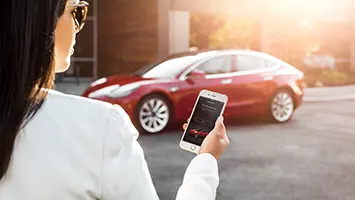

Tesla says 0-60 miles per hour happens in 5.1 seconds in the long-range version (the base car is capable of the same sprint in 5.6 seconds). Five seconds comes a lot more quickly than you might expect. When you don't have to pause for shifts, it feels even faster. The linearity of the acceleration adds to the excitement factor, like you're riding some sort of voltaic slingshot. The quiet adds to the mystique as well. The Model 3 was mild-mannered and well behaved until we intentionally put our foot to the floor, then it let us know that, like its bigger Tesla brethren, it was willing to entertain.
The Model 3 only has two selectable regenerative braking levels: normal and low. Normal took some getting used to, as it is about as aggressive as the regen in the BMW i3. It's great, though, as it lets you mostly do one-pedal driving, but it won't bring you to a full stop (which the i3 will do, if you plan far enough ahead). You can also set the car to either hold or creep when you let off the brake. Choose low regen and turn creep on for a traditional feel, or choose the opposite if you want to feel like you're driving the car of the future. Honestly, after driving with regen and brake hold on, it felt unnatural to switch it back to the normal car copycat version.
All well and good, but how does it do in a more dynamic environment? Mount Hamilton's winding pavement can answer that question. The road varies in both its width and elevation many times before reaching historic Lick Observatory at the peak, and it offers gorgeous views of the valley, the surrounding mountains, occasional wildlife ... and cows. Windows down, and over the quiet whine of the hill-climbing Tesla, we hear mooing. In a traditional vehicle, we wouldn't have heard these ambient nature sounds over the noise of the combustion powertrain — one of the subtle real-world benefits of an EV.
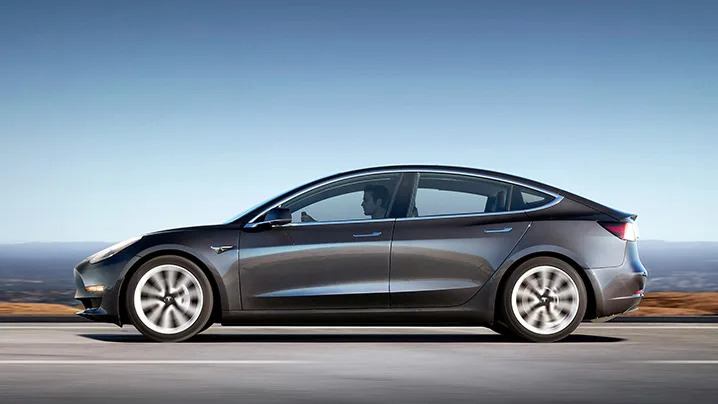
A low center of gravity makes the Model 3 feel nimble despite its 3,800-pound curb weight. The motor (for which Tesla hasn't specified output for the car, but a previous EPA filing suggest about 260 horsepower) provides potent acceleration all the way up to highway speeds. It makes for good fun when exiting a corner, which was the only time we noticed a little wheelspin when stepping on the right pedal. The aggressive regenerative braking also means the Model 3 bleeds off speed with little effort. In addition, the Model 3 feels so capable on a twisty road because it sets up and recovers well by nature of its squatty stance and low center of gravity. The fact that it stays pretty flat in the corners is encouraging.
The Model 3, however, can't defy physics. When you use the 3's brakes, or make a sudden tight steering adjustment, you do feel the car's linear inertia. Our car had the 19-inch wheels, which offered a nice big contact patch, but there isn't much sense of how the tires are gripping coming through the numb steering, which at least offered accurate response. Likewise with the brakes, which just don't communicate enough with the driver. You almost have to listen for the grip, and if you tune in, the sounds of the tires do in fact give you clues as to when you're starting to test the limits. But from there the traction gives up kind of dramatically, almost like on on/off switch rather than a dimmer.
In one particular instance, we were coming into a slight downhill right-hander just a tad hot. We had time to slow down, but we also had completely open roadway in front of us. Rather than dab the brakes for an easy corner, we tried to carry some speed and see if we could push get the Model 3 to trace a hard line under a bit of pressure. As the corner tightened up, we dialed in the appropriate amount of steering angle. We knew it'd either bite down and pull us through, or, well, not. And it didn't. It gave up the lateral grip in a quick moment, and the front wheels plowed laterally as the car shed speed. It recovered quickly, but we had found the grip limit and easily surpassed it. It didn't give way gradually, either, or communicate the loss of grip through the suspension and steering wheel.
Which is mostly OK. This isn't a high-performance enthusiast car, though it is a decent stand-in for one (especially considering the enthusiasm people have for it). Tesla knows a thing or two about performance, and we think the company could fine tune the abrupt transition from grip to dramatic understeer to make it more gradual. In the same vein, the steering could be tuned to be more chatty to the driver about grip levels at the front tires.
For a lot of customers, though — especially greenies moving up in the world from their first-gen Nissan Leaf or Chevy Volt, this will be the quickest, best handling car they've owned, perhaps by an order of magnitude. For those entering from the other side of the performance spectrum, they'll see the opportunities to improve upon the car in the aftermarket, or simply let it live as it is — a super entertaining daily driver that offers quiet quickness in an efficient, stylish and practical package.
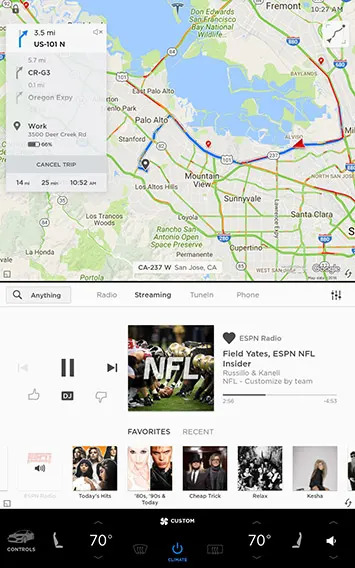

Aside from the steering column, the 15-inch touchscreen affixed to the dash is the only other object in front of the occupants. From there, you control the navigation, the audio, the climate control, the wipers, the cruise control settings, the regen levels, the headlights, the dome light, the display settings, the seat warmers, the steering weight, the steering wheel and mirror adjustments (with the help of the thumbscrolls on the steering wheel), the defrost/defog, even opening the glove box.
For us, this was a lot to get used to, especially on the fly, in traffic. Even after two full days with the car, it felt very unnatural — unwieldy, even — to have to look to our right and dig to find the right menu every single time we wanted to change or check something, anything. And, as much as we could get used to it in time, there's just no quick, easy substitute for a well-placed button or handy gauge. Frankly, the Model 3 is incomplete without them. Robust voice control — which Elon Musk has promised — is not enough. Most important, we need data in our line of sight. Period.
The truth is, it doesn't really matter what we think of the user interface. Even if we outright hated it (we don't), it's still a feature and design choice that will undoubtedly be a huge draw to others. They're going to love the minimalism of the interior (as do we), and they'll be glad to have the buttons and knobs gauges out of the way. Unlike us, many owners might find the all-in-one, tablet-style interface more familiar and streamlined. Fans will defend this thing tooth and nail, we can predict. Still, a button here or there wouldn't ruin the aesthetic. Hopefully those thumbscrolls will be able to perform more user-assigned functions in the future, but there ought to be one or two other controls, either hard or customizable, to provide some user shortcuts.
What seems odd — egregious even — to us is the lack of an optional head-up display. If Tesla doesn't offer one eventually, hopefully the aftermarket can come up with something that plays well with the Tesla's various features and capabilities.
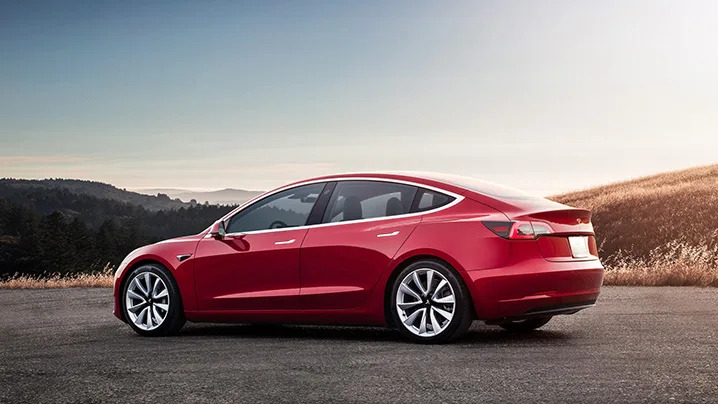
And, as with any purchase, be sure to test drive the competition as well. While stepping on the accelerator of a Nissan Leaf or a won't get your heart pumping like it will in the Model 3, that might be a small price to pay. Its more traditional user interface has withstood the test of time, while the 3's experimental central command approach could seem obsolete before the current batch of preorders even make their way to owners. There's no over-the-air update that can put data in front of your face where it belongs. That's the purview of a mid-cycle refresh. As with any tech, particularly from a relatively new manufacturer, early adopter beware.
If you don't care, that's cool too. You're going to get a lot of kicks out of this car either way. It's fast, capable, and it comes from a company that has the world's attention right now, and for good reason. Tesla may just be responsible for the likes of the Porsche Mission E and Jaguar I-Pace. The Model 3 is no exception. It's another spear in Tesla's vanguard. Perhaps as much as we enjoyed driving the Model 3, we're excited to see what improvements it inspires across other automakers, as well.
This car won't save Tesla, though. No one thing Tesla does will be the answer to the amounts of cash the company burns. Tesla's vision is broad, and having a hand in cars, semis, battery manufacturing, solar systems, and whatever else emerges from Elon's brain all cost big bucks. But each one of those things is another chance at finding something lucrative, and also increases Tesla's profile.
The Model 3, though, will be the first product that makes Tesla a daily part of normal people's lives. Yes, buyers will have to be patient, but that army of hundreds of thousands of prospective owners will eventually be speaking the praises of their fast little Tesla to anyone who will listen.
They will be as dogmatically committed to the 3 as any automotive fanbase, but they'll also be largely correct: The Model 3 is proof that EVs — even the relatively affordable ones — are far more than just appliances. This is a car that stirs up emotions when driving it, and the fact that it does that well is a great thing, not just for customers, but for the entire image of clean cars. And it's undeniably a Tesla, too, despite the lower price point. There's no other EV at this price that's this fun — or this weird.
Related Video:
Model 3 production is off to a slow start, but the first units produced are top-of-the-line, far above the $35,000 base price. The long-range battery ($9,000) normally provides 310 miles of driving range, but the 19-inch wheels ($1,500) reduce that to 290 miles. The high-end interior includes heated power seats, premium audio, tinted glass roof, power heated and folding mirrors, LED fog lights, and integrated smartphone docking. Our tester was also equipped with Advanced Autopilot, worth $5,000, which to quote Tesla, "will match speed to traffic conditions, keep within a lane, automatically change lanes, transition from one freeway to another, exit the freeway and self-park at your destination." It also includes the promise, "Additional features will roll out over time through software updates." Total price on our tester: $57,500 including a grand in destination charges. Later this year, Tesla expects to begin producing the smaller-battery Model 3s, which start at $35,000 and offer 220 miles of range.
Our first impression of the Model 3 as it sat in a crowded parking lot was that it actually blends in pretty well. While a Model S (or especially a Model X) will grab our attention as it passes through our peripheral vision, this more affordable Tesla is far less likely to turn our head from a distance. We found this to be the case on the road, too, despite the 3's current status of rarity. Granted, this Model 3 was a more subdued paint choice in Silver Metallic (a $1,000 option, as is any color but black), and Silicon Valley is, after all, the land of Tesla, and has a dense population of flashier exotics. We just didn't get other drivers or pedestrians craning their necks for a closer look at the Model 3 like we might back home in Michigan.
Upon closer inspection, though, the Model 3's quirks make themselves apparent right away. The novel exterior handle that emerges from the bodywork, and the push-button door opener on the interior remind you this car is different every time you get in or out of it. The overarching theme is high-tech and novel, from the cameras in the B-pillar and on the front fender to the sheer minimalism of the dash in front of you, broken up by the giant central touchscreen. The lack of an instrument cluster behind the steering wheel is a bit disorienting. While we got eventually got used to looking to our right to check our speed, it is not ideal packaging.
Right away, we looked the car over for these oft-maligned remnants of poor build quality. Frankly, based on our experience with this single vehicle, they're overstated, at least from a visual standpoint. If we hadn't been hearing about it, we wouldn't have noticed that the panel gaps (many of which are along curves in the sheet metal) are marginally wider than other vehicles. We didn't see any chrome strips that didn't line up, something we've noticed on GM vehicles. The only thing that really stood out to us was a couple flat spots in the paint, but we can't be sure those didn't happen after the build. Given its early days in Model 3 production, there's probably variance between individual cars, and without discounting those real issues, the car we tested was acceptably screwed together.
The inside of the Model 3 is roomy. Six-footers can sit behind six-footers and be happy. Space in the frunk is limited to shorter luggage — it's perfect for a hefty gym bag but unsuitable for paper grocery bags. The room behind the rear seats is ample for that. One beautiful thing about the Model 3 is the way the space opens up when you fold the rear seats down. We won't spoil the visual, but check out our list of five cool features to see how an out-of-shape dad fares on an inflatable twin mattress in the back of the Model 3.




The interior materials feel appropriate for the price point: upscale where you need it, and the harder bits are at least nice to look at. The leather steering wheel is smooth, slightly soft (al dente, maybe) and grippy. The wood across the dash looks nice, but the piano black plastic on the doors and center console was already showing some minor surface wear — we were warned that it could scratch easily. The doors have leather handles and strips of ultrasuede trim. The seats are very comfortable and supportive, but we would've loved to have ventilated chairs — which Tesla has even discontinued in the Models S and X — in the California sun. The giant touchscreen looks heavy, but it is firmly attached, and didn't wiggle a bit when we messed with it. The magnetic cargo lids in the center console require an unusually gentle touch to get them to stay shut (we thought they were broken when we first tried to close them).
The interesting part of centralizing most of the controls on the central display is how little you're touching the rest of the interior. Beyond that, the doors and center console (glossy plastic), steering wheel (leather), and left and right stalks on the steering column (typical plastic fare, as in any other car), there's really no reason to feel other parts of the interior. They don't really call out to you to rub your hand across them, but if you did, you might find, for instance, that something like the textile headliner looks nicer than it feels.
We were able to use the Tesla app to sync the vehicle up to our phone, which meant we could leave the key — a little black card in the Model 3, while other Teslas use a fob — in our wallet and forget about it. It made getting into the car, driving away, parking, and leaving a seamless experience, as it communicated with our phone via Bluetooth. We didn't have to think about turning it on — there's no push-button ignition apart from the brake pedal — or locking it as we walked away. The only thing we thought was kind of funny was that if we stood near the car with the phone in our pocket, the side mirrors would fold and unfold intermittently, as though the car didn't know whether we were coming or going.


Driving the Model 3
The first part of our drive took us through city streets before crossing San Jose via highway on our way to some special mountain curves. Driving down the road, the Model 3 is, as you would expect, quiet. As you pick up speed driving on the highway there's little wind noise, but a bit more tire noise (it's worth noting here that our tester was equipped with the optional 19-inch wheels paired with all-season tires). The low background noise allows you to hear all the whirrs and whines of the mechanics and electronics, or, better yet, the radio. The stereo sounded quite crisp without being tinny, and full without being too bassy. We have no complaints here; it's not quite Burmeister, but we'd take it over most Bose systems. Put on your favorite album and enjoy.Tesla says 0-60 miles per hour happens in 5.1 seconds in the long-range version (the base car is capable of the same sprint in 5.6 seconds). Five seconds comes a lot more quickly than you might expect. When you don't have to pause for shifts, it feels even faster. The linearity of the acceleration adds to the excitement factor, like you're riding some sort of voltaic slingshot. The quiet adds to the mystique as well. The Model 3 was mild-mannered and well behaved until we intentionally put our foot to the floor, then it let us know that, like its bigger Tesla brethren, it was willing to entertain.
The Model 3 only has two selectable regenerative braking levels: normal and low. Normal took some getting used to, as it is about as aggressive as the regen in the BMW i3. It's great, though, as it lets you mostly do one-pedal driving, but it won't bring you to a full stop (which the i3 will do, if you plan far enough ahead). You can also set the car to either hold or creep when you let off the brake. Choose low regen and turn creep on for a traditional feel, or choose the opposite if you want to feel like you're driving the car of the future. Honestly, after driving with regen and brake hold on, it felt unnatural to switch it back to the normal car copycat version.
All well and good, but how does it do in a more dynamic environment? Mount Hamilton's winding pavement can answer that question. The road varies in both its width and elevation many times before reaching historic Lick Observatory at the peak, and it offers gorgeous views of the valley, the surrounding mountains, occasional wildlife ... and cows. Windows down, and over the quiet whine of the hill-climbing Tesla, we hear mooing. In a traditional vehicle, we wouldn't have heard these ambient nature sounds over the noise of the combustion powertrain — one of the subtle real-world benefits of an EV.

A low center of gravity makes the Model 3 feel nimble despite its 3,800-pound curb weight. The motor (for which Tesla hasn't specified output for the car, but a previous EPA filing suggest about 260 horsepower) provides potent acceleration all the way up to highway speeds. It makes for good fun when exiting a corner, which was the only time we noticed a little wheelspin when stepping on the right pedal. The aggressive regenerative braking also means the Model 3 bleeds off speed with little effort. In addition, the Model 3 feels so capable on a twisty road because it sets up and recovers well by nature of its squatty stance and low center of gravity. The fact that it stays pretty flat in the corners is encouraging.
The Model 3, however, can't defy physics. When you use the 3's brakes, or make a sudden tight steering adjustment, you do feel the car's linear inertia. Our car had the 19-inch wheels, which offered a nice big contact patch, but there isn't much sense of how the tires are gripping coming through the numb steering, which at least offered accurate response. Likewise with the brakes, which just don't communicate enough with the driver. You almost have to listen for the grip, and if you tune in, the sounds of the tires do in fact give you clues as to when you're starting to test the limits. But from there the traction gives up kind of dramatically, almost like on on/off switch rather than a dimmer.
In one particular instance, we were coming into a slight downhill right-hander just a tad hot. We had time to slow down, but we also had completely open roadway in front of us. Rather than dab the brakes for an easy corner, we tried to carry some speed and see if we could push get the Model 3 to trace a hard line under a bit of pressure. As the corner tightened up, we dialed in the appropriate amount of steering angle. We knew it'd either bite down and pull us through, or, well, not. And it didn't. It gave up the lateral grip in a quick moment, and the front wheels plowed laterally as the car shed speed. It recovered quickly, but we had found the grip limit and easily surpassed it. It didn't give way gradually, either, or communicate the loss of grip through the suspension and steering wheel.
Which is mostly OK. This isn't a high-performance enthusiast car, though it is a decent stand-in for one (especially considering the enthusiasm people have for it). Tesla knows a thing or two about performance, and we think the company could fine tune the abrupt transition from grip to dramatic understeer to make it more gradual. In the same vein, the steering could be tuned to be more chatty to the driver about grip levels at the front tires.
For a lot of customers, though — especially greenies moving up in the world from their first-gen Nissan Leaf or Chevy Volt, this will be the quickest, best handling car they've owned, perhaps by an order of magnitude. For those entering from the other side of the performance spectrum, they'll see the opportunities to improve upon the car in the aftermarket, or simply let it live as it is — a super entertaining daily driver that offers quiet quickness in an efficient, stylish and practical package.


A joy to drive, a pain to use
It's the only EV this close to this quick at this price point, but in particular it's the combination of quickness and affordability that's compelling. What sets it apart beyond that is something else entirely: the user interface.Aside from the steering column, the 15-inch touchscreen affixed to the dash is the only other object in front of the occupants. From there, you control the navigation, the audio, the climate control, the wipers, the cruise control settings, the regen levels, the headlights, the dome light, the display settings, the seat warmers, the steering weight, the steering wheel and mirror adjustments (with the help of the thumbscrolls on the steering wheel), the defrost/defog, even opening the glove box.
For us, this was a lot to get used to, especially on the fly, in traffic. Even after two full days with the car, it felt very unnatural — unwieldy, even — to have to look to our right and dig to find the right menu every single time we wanted to change or check something, anything. And, as much as we could get used to it in time, there's just no quick, easy substitute for a well-placed button or handy gauge. Frankly, the Model 3 is incomplete without them. Robust voice control — which Elon Musk has promised — is not enough. Most important, we need data in our line of sight. Period.
The truth is, it doesn't really matter what we think of the user interface. Even if we outright hated it (we don't), it's still a feature and design choice that will undoubtedly be a huge draw to others. They're going to love the minimalism of the interior (as do we), and they'll be glad to have the buttons and knobs gauges out of the way. Unlike us, many owners might find the all-in-one, tablet-style interface more familiar and streamlined. Fans will defend this thing tooth and nail, we can predict. Still, a button here or there wouldn't ruin the aesthetic. Hopefully those thumbscrolls will be able to perform more user-assigned functions in the future, but there ought to be one or two other controls, either hard or customizable, to provide some user shortcuts.
What seems odd — egregious even — to us is the lack of an optional head-up display. If Tesla doesn't offer one eventually, hopefully the aftermarket can come up with something that plays well with the Tesla's various features and capabilities.
So, what about Autopilot?
Ugh. That's going to require its own post. You can read that here.
Our final thoughts
The Tesla Model 3 is a great car to drive, with a quiet ride, punchy acceleration and the ability to make almost any road fun. It has some serious flaws to consider before committing to ownership, which mostly concern the user interface. Hard as it is — especially right now, with so few of them out in the world — we really suggest taking the chance to spend some time in one before you buy or lease. Find an owner. Beg, borrow ... don't steal ... but make sure you can live without the user interface you're used to, especially if adaptive cruise control is on your list of necessities.And, as with any purchase, be sure to test drive the competition as well. While stepping on the accelerator of a Nissan Leaf or a won't get your heart pumping like it will in the Model 3, that might be a small price to pay. Its more traditional user interface has withstood the test of time, while the 3's experimental central command approach could seem obsolete before the current batch of preorders even make their way to owners. There's no over-the-air update that can put data in front of your face where it belongs. That's the purview of a mid-cycle refresh. As with any tech, particularly from a relatively new manufacturer, early adopter beware.
If you don't care, that's cool too. You're going to get a lot of kicks out of this car either way. It's fast, capable, and it comes from a company that has the world's attention right now, and for good reason. Tesla may just be responsible for the likes of the Porsche Mission E and Jaguar I-Pace. The Model 3 is no exception. It's another spear in Tesla's vanguard. Perhaps as much as we enjoyed driving the Model 3, we're excited to see what improvements it inspires across other automakers, as well.
This car won't save Tesla, though. No one thing Tesla does will be the answer to the amounts of cash the company burns. Tesla's vision is broad, and having a hand in cars, semis, battery manufacturing, solar systems, and whatever else emerges from Elon's brain all cost big bucks. But each one of those things is another chance at finding something lucrative, and also increases Tesla's profile.
The Model 3, though, will be the first product that makes Tesla a daily part of normal people's lives. Yes, buyers will have to be patient, but that army of hundreds of thousands of prospective owners will eventually be speaking the praises of their fast little Tesla to anyone who will listen.
They will be as dogmatically committed to the 3 as any automotive fanbase, but they'll also be largely correct: The Model 3 is proof that EVs — even the relatively affordable ones — are far more than just appliances. This is a car that stirs up emotions when driving it, and the fact that it does that well is a great thing, not just for customers, but for the entire image of clean cars. And it's undeniably a Tesla, too, despite the lower price point. There's no other EV at this price that's this fun — or this weird.
Related Video:









Sign in to post
Please sign in to leave a comment.
Continue